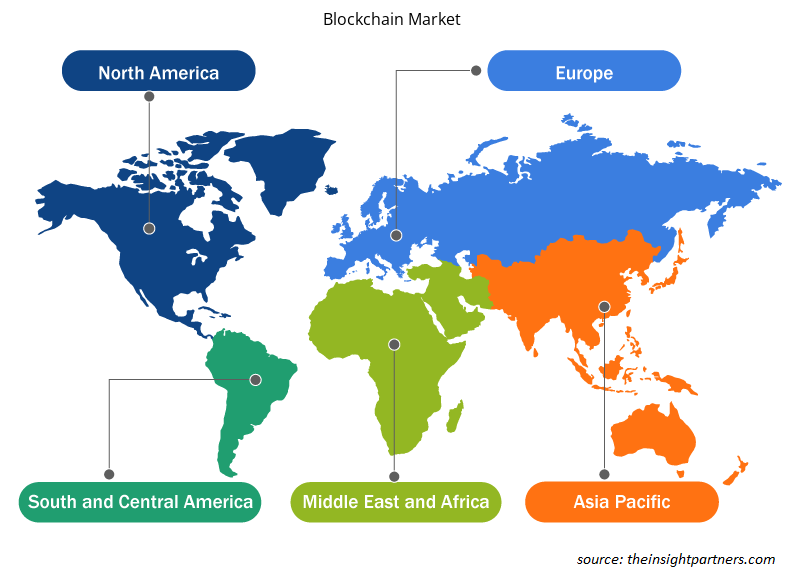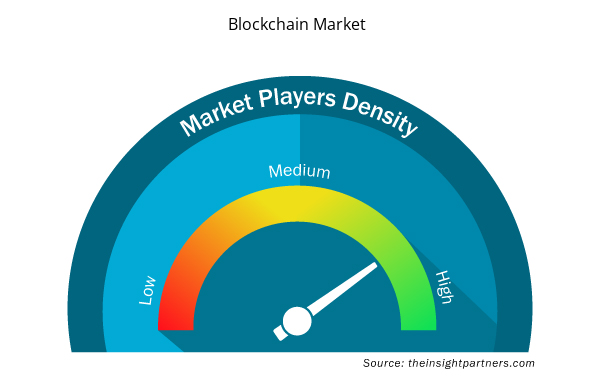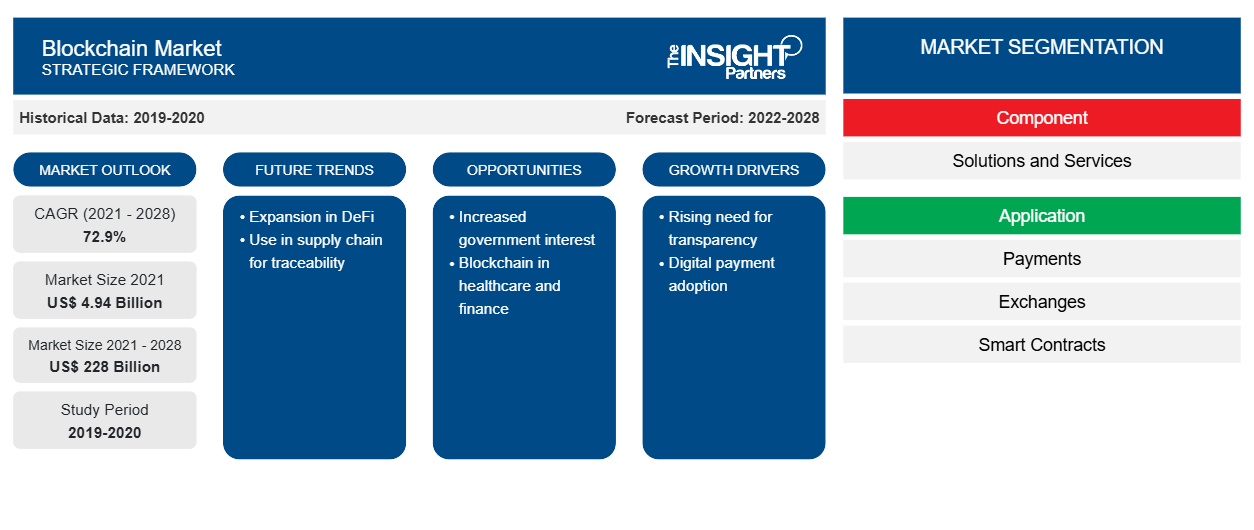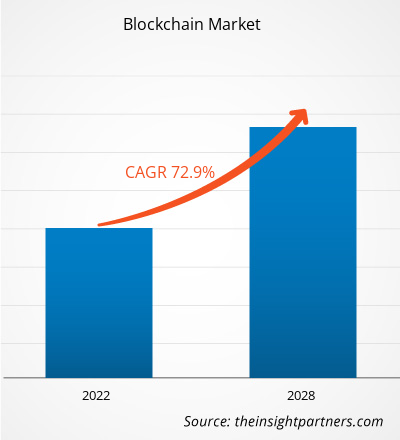Si prevede che il mercato blockchain crescerà da 4.935,0 milioni di dollari nel 2021 a 227.996,6 milioni di dollari entro il 2028; si stima che crescerà a un CAGR del 72,9% dal 2021 al 2028.
La tecnologia Blockchain e le sue applicazioni nel settore bancario, dei servizi finanziari e delle assicurazioni (BFSI) hanno attirato molta attenzione negli ultimi anni, principalmente per la sua capacità di trasformare le fondamenta e i modelli aziendali dei settori esistenti. Attualmente, a parte le applicazioni di criptovaluta , le altre principali applicazioni pratiche di Blockchain sono ancora nel settore bancario e finanziario; tuttavia, varie aziende e istituzioni stanno ora sviluppando rapidamente soluzioni basate su Blockchain per risolvere complessi problemi aziendali. In termini generali, Blockchain è un sottoinsieme di una più ampia tecnologia di registro distribuito (DLT) e combina tre concetti significativi: crittografia, contratti intelligenti e progettazione di registri distribuiti. La tecnologia di registro distribuito (DLT) è un approccio in rapida ascesa che registra e condivide dati su vari archivi/registri dati. DLT facilita la registrazione, la condivisione e la sincronizzazione di transazioni e dati su una rete distribuita di diversi partecipanti alla rete.
Si prevede che il mercato globale Blockchain mostrerà una crescita molto elevata nel prossimo futuro. I principali fattori trainanti che contribuiscono alla crescita del mercato includono un'ampia adozione di soluzioni Blockchain nel settore BFSI; vantaggi quali maggiore trasparenza, maggiore efficienza operativa e notevoli risparmi sui costi; e un aumento del numero di startup innovative. Durante il periodo di previsione, si prevede che tendenze quali il crescente supporto e iniziative governative e una combinazione di Blockchain e intelligenza artificiale per applicazioni avanzate forniranno interessanti opportunità per gli operatori che operano nel mercato Blockchain.
Personalizza questo report in base alle tue esigenze
Riceverai la personalizzazione gratuita di qualsiasi report, comprese parti di questo report, o analisi a livello nazionale, pacchetto dati Excel, oltre a usufruire di grandi offerte e sconti per start-up e università
- Scopri le principali tendenze di mercato in questo rapporto.Questo campione GRATUITO includerà analisi di dati che spaziano dalle tendenze di mercato alle stime e alle previsioni.
Impatto della pandemia di COVID-19 sul mercato Blockchain
Mentre la pandemia di COVID-19 ha posto problemi significativi per le organizzazioni in tutto il mondo, il mercato Blockchain è cresciuto costantemente durante la crisi. Soprattutto, durante l'epidemia, gli operatori sanitari hanno iniziato a utilizzare chat, e-mail, telefoni e conversazioni video per curare i pazienti da remoto, impedendo al virus di diffondersi. L'uso di strumenti di penetration testing per transazioni online sicure e dati conversazionali è aumentato a causa di ciò. L'adozione del mercato Blockchain da parte di varie aziende per fornire una sicurezza ottimale durante un ambiente caotico è anche un elemento cruciale che guida il mercato verticale Blockchain. La pandemia di COVID-19 ha avuto un impatto su tutti gli aspetti della società, compresi individui e aziende. L'ecosistema di Internet è diventato sempre più importante a livello globale. La dipendenza dalle imprese online è aumentata notevolmente a causa dello scoppio del COVID-19. Internet viene utilizzato da BFSI, sanità e scienze della vita, produzione, vendita al dettaglio, trasporti e logistica e altri settori per fornire servizi essenziali ai consumatori. La domanda di una Blockchain è aumentata tra i fornitori. Vari governi e agenzie di regolamentazione hanno costretto sia le organizzazioni pubbliche che private ad accettare nuove tecniche di telelavoro e di mantenimento della distanza sociale sulla scia della pandemia di COVID-19. Da allora, le pratiche aziendali digitali e l'uso di e-mail su server domestici sono diventati il nuovo piano di continuità aziendale (BCP) per una varietà di aziende.
Approfondimenti sul mercato Blockchain
Tutti i principali settori industriali in tutto il mondo, tra cui BFSI, vendita al dettaglio, logistica e trasporti, sanità, automotive, media e intrattenimento e governo, stanno abbracciando e investendo in tecnologie dirompenti come Blockchain, intelligenza artificiale, Internet of Things (IoT), big data e analisi predittiva . La crescente adozione della tecnologia Blockchain è guidata dai casi d'uso di successo e dalla prova dei concetti Blockchain in vari settori che hanno portato a una maggiore trasparenza, a una maggiore efficienza operativa e a costi ridotti. La natura delle aziende sta diventando molto competitiva in ogni settore in tutto il mondo e, per competere in modo efficiente, oggigiorno le aziende si affidano all'integrazione della tecnologia in varie funzioni aziendali per aumentare la trasparenza e l'efficienza operativa.
Blockchain ha diverse applicazioni nel settore finanziario, tra cui pagamenti, mercati dei capitali, servizi commerciali, gestione di investimenti e patrimoni e borse valori e materie prime. I notevoli risparmi sui costi sono uno dei principali fattori trainanti per la crescente adozione di Blockchain in questo settore.
L'uso della tecnologia Blockchain ha reso le transazioni più trasparenti nei principali settori. Questa trasparenza aiuta a prevenire frodi e attività non autorizzate in settori quali servizi finanziari, governo e sanità, dove i dati sensibili vengono condivisi tra i partecipanti. Blockchain semplifica e automatizza i tradizionali processi cartacei, che richiedono molto tempo e sono soggetti a errori umani. Ciò rende le transazioni rapide ed efficienti, aumentando così l'efficienza operativa.
La riduzione dei costi e il risparmio sui costi sono le principali priorità per qualsiasi azienda. Blockchain elimina terze parti o intermediari non necessari per ridurre tempi e costi. Con tutti questi vantaggi, Blockchain consente alle aziende di migliorare l'efficienza operativa, la trasparenza, ridurre i costi operativi e, quindi, aiutarle a migliorare la qualità del servizio e l'esperienza del cliente.
Informazioni dettagliate sui segmenti dei componenti
In base al componente, il mercato blockchain può essere suddiviso in servizi e soluzioni. Il segmento delle soluzioni ha guidato il mercato blockchain. La crescente adozione di soluzioni blockchain dovuta alla loro capacità di fornire maggiore trasparenza nella gestione delle transazioni finanziarie in bitcoin, nonché all'aumento della digitalizzazione, sta spingendo in avanti il mercato blockchain. I clienti possono utilizzare la piattaforma blockchain del mercato per creare ambienti blockchain privati, pubblici e basati su consorzi e costruire le proprie applicazioni e soluzioni blockchain. Persone, prodotti, app e servizi possono interagire attraverso la rete blockchain, i provider cloud e le aziende che utilizzano queste piattaforme.
Approfondimenti regionali sul mercato Blockchain
Le tendenze regionali e i fattori che influenzano il mercato Blockchain durante il periodo di previsione sono stati ampiamente spiegati dagli analisti di Insight Partners. Questa sezione discute anche i segmenti e la geografia del mercato Blockchain in Nord America, Europa, Asia Pacifico, Medio Oriente e Africa e Sud e Centro America.

- Ottieni i dati specifici regionali per il mercato Blockchain
Ambito del rapporto sul mercato Blockchain
| Attributo del report | Dettagli |
|---|---|
| Dimensioni del mercato nel 2021 | 4,94 miliardi di dollari USA |
| Dimensioni del mercato entro il 2028 | 228 miliardi di dollari USA |
| CAGR globale (2021 - 2028) | 72,9% |
| Dati storici | 2019-2020 |
| Periodo di previsione | 2022-2028 |
| Segmenti coperti | Per componente
|
| Regioni e Paesi coperti | America del Nord
|
| Leader di mercato e profili aziendali chiave |
|
Densità degli attori del mercato Blockchain: comprendere il suo impatto sulle dinamiche aziendali
Il mercato Blockchain sta crescendo rapidamente, spinto dalla crescente domanda degli utenti finali dovuta a fattori quali l'evoluzione delle preferenze dei consumatori, i progressi tecnologici e una maggiore consapevolezza dei vantaggi del prodotto. Con l'aumento della domanda, le aziende stanno ampliando le loro offerte, innovando per soddisfare le esigenze dei consumatori e capitalizzando sulle tendenze emergenti, il che alimenta ulteriormente la crescita del mercato.
La densità degli operatori di mercato si riferisce alla distribuzione di aziende o società che operano in un particolare mercato o settore. Indica quanti concorrenti (operatori di mercato) sono presenti in un dato spazio di mercato in relazione alle sue dimensioni o al valore di mercato totale.
Le principali aziende che operano nel mercato Blockchain sono:
- Società IBM
- Società Microsoft
- Accentura
- Amazzone
- SAP SE
Disclaimer : le aziende elencate sopra non sono classificate secondo un ordine particolare.

- Ottieni una panoramica dei principali attori del mercato Blockchain
Approfondimenti sui segmenti applicativi
Il mercato globale della blockchain è segmentato in pagamenti, scambi, contratti intelligenti, documentazione, identità digitale, governance, rischio e conformità e altri. Il segmento dei pagamenti ha guidato il mercato della blockchain. Gli altri segmenti includono voto digitale, ride-sharing, pubblicità e molti altri. La blockchain riduce i costi, aumenta la sicurezza, aumenta la trasparenza e diminuisce i tempi di transazione, riducendo al contempo la necessità di una terza parte fidata. La blockchain gestisce un set variabile di regole e configurazioni. Un'applicazione come i contratti intelligenti può migliorare notevolmente l'efficienza dei processi, l'affidabilità, la trasparenza e ridurre i rischi. Gli usi potenziali della blockchain sono vari e ampi e la tecnologia sta diventando sempre più diffusa.
Approfondimenti sul segmento di tipo verticale del settore
Blockchain è un registro distribuito in grado di verificare e registrare automaticamente un elevato volume di transazioni digitali, indipendentemente dalla posizione. Poiché le startup utilizzano la tecnologia blockchain per promuovere una maggiore trasparenza nella rete di informazioni digitali, stanno aumentando la consapevolezza della tecnologia blockchain in vari settori. In base al settore verticale, il mercato globale Blockchain è categorizzato in BFSI, vendita al dettaglio, governo, trasporti e logistica, assistenza sanitaria, automotive, media e intrattenimento e altri. Il segmento degli altri include produzione, immobiliare, energia e servizi di pubblica utilità, telecomunicazioni e sport.
Gli operatori del mercato Blockchain si concentrano su innovazioni e sviluppi di nuovi prodotti integrando tecnologie e funzionalità avanzate per competere. Ad esempio, nel 2019, Carrefour e Nestle hanno stretto una partnership con IBM per utilizzare la tecnologia blockchain nelle categorie alimentari. La partnership consentirebbe una rapida espansione di una rete basata su blockchain che porta maggiore trasparenza alla filiera alimentare globale di rivenditori, coltivatori, grossisti, trasformatori, distributori e produttori.
Mercato Blockchain – Profili aziendali
- Società IBM
- Società Microsoft
- Accentura
- Amazzone
- Servizio SAP
- Sviluppo aziendale Hewlett Packard (HPE)
- Società Oracle
- Società Intel
- Ondulazione
- Gruppo Bitfury
- Analisi storica (2 anni), anno base, previsione (7 anni) con CAGR
- Analisi PEST e SWOT
- Valore/volume delle dimensioni del mercato - Globale, regionale, nazionale
- Industria e panorama competitivo
- Set di dati Excel



Report Coverage
Revenue forecast, Company Analysis, Industry landscape, Growth factors, and Trends

Segment Covered
This text is related
to segments covered.

Regional Scope
North America, Europe, Asia Pacific, Middle East & Africa, South & Central America

Country Scope
This text is related
to country scope.
Domande frequenti
Extensive Adoption of Blockchain Solutions in BFSI Industry Vertical
High Transparency and Operational Efficiency with Substantial Cost Savings
The rising Government Support and Initiatives Worldwide is anticipated to offer ample future growth opportunity to the Blockchain market solution providers over the forecast period of 2021 to 2028. The adoption of Blockchain technology is still in its nascent stages worldwide, and it is growing at different speeds in different geographies. The adoption of Blockchain in particular geography depends on government support and a favorable business environment. Blockchain technology has immense potential to transform businesses and government services. For sustainable growth of the Blockchain market, a unified regulatory framework is crucial, and it depends on the governments' will. The opportunities in various countries will grow exponentially depending on the supportive government initiatives worldwide. Various governments worldwide are coming at the forefront to help the fast adoption of Blockchain. For instance, the European Commission has recently supported signing a 27-country pact on Blockchain, known as the European Blockchain Partnership. This partnership will look into EU-wide collaboration on various regulatory and technical matters related to the Blockchain market. The EU is also planning to invest EUR 300 million in Blockchain over the next three years. On similar lines, the UAE in the Middle East has also formulated an ideal strategy for Blockchain. The focus of this strategy is to do 50% of all government transactions on Blockchain technology by 2021. Also, Sweden has announced its Blockchain-based land registry project. Moreover, the rising use cases of Blockchain in government applications is another positive sign for companies operating in this market. Some of the most common public sector use cases include digital identity, digital voting, inter & intragovernmental transactions, documentation records, and supply chain traceability. The most active governments adopting, investing, and exploring Blockchain include Japan, South Korea, Switzerland, Singapore, Australia, Russia, Canada, Chile, and the Republic of Georgia. All these examples of Blockchain use cases in the government sector and an increase in government support in various geographies are expected to provide ample opportunities to market players operating or planning to enter the Blockchain market
Key companies in the Blockchain market include IBM Corporation, Microsoft Corporation, Accenture, Amazon Web Services, SAP Se, Hewlett Packard Enterprise Development LP (HPE), Oracle Corporation, Intel Corporation, Ripple, and Bitfury Group.
The US is a significant contributor to the blockchain market in 2020. The US accounts for the largest market share in the blockchain market. The rapid evolution of blockchain technology is witnessing the developments of new platforms, partnerships, and applications in the country. Many companies in the U.S are collaborating with blockchain startups and some of the large players. Also, with the increased digitalization of business, maintaining trust can become expensive, inefficient, and time-consuming. Blockchain improves the reliability of data and reduced chances of fraud. These factors would fuel the demand of blockchain technology in the U.S.
Based on component, the global Blockchain market is segmented into Services, and Solution. The solution segment led the Blockchain market with a market share of 67.2% in 2020. It is expected to account for 69.1% of the total market in 2028.
Artificial intelligence (AI) and its applications such as machine learning and deep learning have grown tremendously over the last few years. AI is being utilized extensively in numerous areas, ranging from cloud computing applications to digital assistants and self-driving/autonomous vehicles. With some of the most prominent tech players from the US and China, such as Google, Amazon, Apple, Facebook, Microsoft, IBM, Baidu, Alibaba, and Tencent, at the forefront of artificial intelligence research and development, this technology is expected to change the face of every industry in the coming future. Blockchain technology and Artificial intelligence are two breakthrough technologies, and they work very well in unison. Combining these two technologies helps build and organize massive databases, strengthen various cybersecurity protocols, and perform tasks in less time than humans. Artificial intelligence works on the data gathered from multiple sources to extract valuable insights related to various business processes and customer preferences while saving costs and increasing operational efficiency for companies. Using AI to collect information is the most common way to use artificial intelligence technology. This data collection and its ethical use pose difficulties in the wide adoption of AI. In this matter, Blockchain can help by storing the AI mechanisms that process data on a distributed and decentralized registry which will help in securing personal information. In Blockchain, users can determine themselves who should be given access to their personal information by using private and public keys. Artificial intelligence-powered blockchains can provide decentralized identification to protect user identity. Various companies are using Blockchain and AI together in diverse applications. For instance, VIA uses Blockchain and AI to help large energy companies conceptualize and use their data more effectively. AlphaNetworks is a Blockchain-powered entertainment platform that uses Artificial Intelligence to improve audience analytics and viewership algorithms. NetObjex is a smart city infrastructure platform that uses Blockchain, IoT, and AI to power connected devices and cloud-based products.
Trends and growth analysis reports related to Banking, Financial Services, and Insurance : READ MORE..
The List of Companies - Blockchain Market
- IBM Corporation
- Microsoft Corporation
- Accenture
- Amazon
- SAP SE
- Bitfury Group Limited
- Ripple Labs Inc.
- Hewlett Packard Enterprise Development LP (HPE)
- Oracle Corporation
- Intel Corporation
The Insight Partners performs research in 4 major stages: Data Collection & Secondary Research, Primary Research, Data Analysis and Data Triangulation & Final Review.
- Data Collection and Secondary Research:
As a market research and consulting firm operating from a decade, we have published and advised several client across the globe. First step for any study will start with an assessment of currently available data and insights from existing reports. Further, historical and current market information is collected from Investor Presentations, Annual Reports, SEC Filings, etc., and other information related to company’s performance and market positioning are gathered from Paid Databases (Factiva, Hoovers, and Reuters) and various other publications available in public domain.
Several associations trade associates, technical forums, institutes, societies and organization are accessed to gain technical as well as market related insights through their publications such as research papers, blogs and press releases related to the studies are referred to get cues about the market. Further, white papers, journals, magazines, and other news articles published in last 3 years are scrutinized and analyzed to understand the current market trends.
- Primary Research:
The primarily interview analysis comprise of data obtained from industry participants interview and answers to survey questions gathered by in-house primary team.
For primary research, interviews are conducted with industry experts/CEOs/Marketing Managers/VPs/Subject Matter Experts from both demand and supply side to get a 360-degree view of the market. The primary team conducts several interviews based on the complexity of the markets to understand the various market trends and dynamics which makes research more credible and precise.
A typical research interview fulfils the following functions:
- Provides first-hand information on the market size, market trends, growth trends, competitive landscape, and outlook
- Validates and strengthens in-house secondary research findings
- Develops the analysis team’s expertise and market understanding
Primary research involves email interactions and telephone interviews for each market, category, segment, and sub-segment across geographies. The participants who typically take part in such a process include, but are not limited to:
- Industry participants: VPs, business development managers, market intelligence managers and national sales managers
- Outside experts: Valuation experts, research analysts and key opinion leaders specializing in the electronics and semiconductor industry.
Below is the breakup of our primary respondents by company, designation, and region:

Once we receive the confirmation from primary research sources or primary respondents, we finalize the base year market estimation and forecast the data as per the macroeconomic and microeconomic factors assessed during data collection.
- Data Analysis:
Once data is validated through both secondary as well as primary respondents, we finalize the market estimations by hypothesis formulation and factor analysis at regional and country level.
- Macro-Economic Factor Analysis:
We analyse macroeconomic indicators such the gross domestic product (GDP), increase in the demand for goods and services across industries, technological advancement, regional economic growth, governmental policies, the influence of COVID-19, PEST analysis, and other aspects. This analysis aids in setting benchmarks for various nations/regions and approximating market splits. Additionally, the general trend of the aforementioned components aid in determining the market's development possibilities.
- Country Level Data:
Various factors that are especially aligned to the country are taken into account to determine the market size for a certain area and country, including the presence of vendors, such as headquarters and offices, the country's GDP, demand patterns, and industry growth. To comprehend the market dynamics for the nation, a number of growth variables, inhibitors, application areas, and current market trends are researched. The aforementioned elements aid in determining the country's overall market's growth potential.
- Company Profile:
The “Table of Contents” is formulated by listing and analyzing more than 25 - 30 companies operating in the market ecosystem across geographies. However, we profile only 10 companies as a standard practice in our syndicate reports. These 10 companies comprise leading, emerging, and regional players. Nonetheless, our analysis is not restricted to the 10 listed companies, we also analyze other companies present in the market to develop a holistic view and understand the prevailing trends. The “Company Profiles” section in the report covers key facts, business description, products & services, financial information, SWOT analysis, and key developments. The financial information presented is extracted from the annual reports and official documents of the publicly listed companies. Upon collecting the information for the sections of respective companies, we verify them via various primary sources and then compile the data in respective company profiles. The company level information helps us in deriving the base number as well as in forecasting the market size.
- Developing Base Number:
Aggregation of sales statistics (2020-2022) and macro-economic factor, and other secondary and primary research insights are utilized to arrive at base number and related market shares for 2022. The data gaps are identified in this step and relevant market data is analyzed, collected from paid primary interviews or databases. On finalizing the base year market size, forecasts are developed on the basis of macro-economic, industry and market growth factors and company level analysis.
- Data Triangulation and Final Review:
The market findings and base year market size calculations are validated from supply as well as demand side. Demand side validations are based on macro-economic factor analysis and benchmarks for respective regions and countries. In case of supply side validations, revenues of major companies are estimated (in case not available) based on industry benchmark, approximate number of employees, product portfolio, and primary interviews revenues are gathered. Further revenue from target product/service segment is assessed to avoid overshooting of market statistics. In case of heavy deviations between supply and demand side values, all thes steps are repeated to achieve synchronization.
We follow an iterative model, wherein we share our research findings with Subject Matter Experts (SME’s) and Key Opinion Leaders (KOLs) until consensus view of the market is not formulated – this model negates any drastic deviation in the opinions of experts. Only validated and universally acceptable research findings are quoted in our reports.
We have important check points that we use to validate our research findings – which we call – data triangulation, where we validate the information, we generate from secondary sources with primary interviews and then we re-validate with our internal data bases and Subject matter experts. This comprehensive model enables us to deliver high quality, reliable data in shortest possible time.


 Ottieni un campione gratuito per questo repot
Ottieni un campione gratuito per questo repot